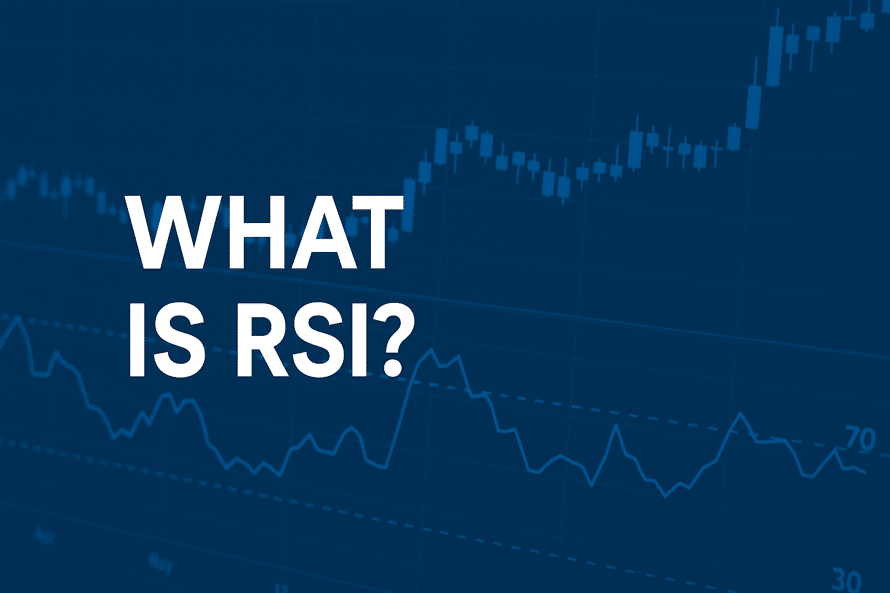
Stock and crypto traders make use of the Relative Strength Index (RSI). RSI is a momentum indicator that helps traders determine if an asset has been bought or sold at an excessive price. If you are curious about RSI, it is a tool used to detect changes in the rate and direction of price movements. RSI values vary between 0 and 100 and are not hard to comprehend. Traders count on it to find signals when to buy or sell.
Any level above 70 may indicate an overbought situation, while a level below 30 can suggest that the market is oversold. RSI may indicate the power of a trend and possible changes in direction. In this blog post, you will learn what is RSI, how to read the signals, and ways to make good use of it.
What Is the Relative Strength Index (RSI)?
The RSI is a technical indicator that enables traders to determine if an asset’s price is rising too quickly or falling too rapidly. The moving average is calculated by comparing the price’s recent fluctuations in value. The aim is to determine whether a market is trending upward or downward.
History and Development by J. Welles Wilder Jr.
J. Welles Wilder Jr. developed RSI in 1978. He shared the ideas in his book, New Concepts in Technical Trading Systems. An engineer by training before becoming a trader, Wilder searched for a way to show market strength using charts quickly. Following that, the RSI has played a significant role in technical analysis.
Why RSI Remains Popular in Modern Trading
Are you wondering what is RSI and why it is relevant in the present day? RSI remains popular among traders as it indicates when and where to enter and exit the market. It draws attention to exceptional market conditions and shifts in overall market movement.
How RSI Is Calculated
RSI is usually determined over 14 days and can have a score ranging from zero to 100. It provides quick signals indicating whether it is the right time to buy or sell an asset based on overselling or overbuying.
Step-by-Step RSI Formula (14-Period Default)
Use the following formula to determine RSI:
RSI is equal to 100 – [100 ÷ (1 + (Average Gain ÷ Average Loss))]
The average gain and loss over 14 periods are first calculated. Next, use the formula.
To make values current:
Average Gain = [(Previous Avg Gain × 13) + Current Gain] ÷ 14
Average Loss = [(Previous Avg Loss × 13) + Current Loss] ÷ 14
Differences Between Simple RSI and Wilder’s RSI
The relative strength (RS) in Simple RSI is calculated using simple averages of gains and losses.
Wilder’s smoothing, a modified exponential average, is used by RS in Wilder’s RSI:
Wilder’s Smoothing = Previous MA + (1/n) × (Close – Previous MA)
Signals from Wilder’s version are more dependable and smoother.
Example Calculation and Interpretation
Assume that your average gain over 14 days is 1.2 and your average loss is 0.8.
RS = 1.2 ÷ 0.8 = 1.5 RSI = 100 – [100 ÷ (1 + 1.5)] = 60
Overbought is indicated by an RSI above 70.
Below 30 indicates oversold.
An RSI of 50 indicates a neutral market.
Interpreting RSI Levels
RSI is a tool traders use to decide whether a stock price is overbought or oversold by checking a value between 0 and 100. It can help them determine whether a market has reached an extreme position that may reverse soon.
Overbought and Oversold Thresholds (30/70 and 20/80)
Technical traders use levels of 70 and 30 when dealing with RSI. A reading of over 70 on the RSI line typically indicates that the stock has risen too much. When the stock trades under 30, some traders consider it to be oversold. Other traders rely on 80/20 signals when they want more extreme trading indications.
RSI Behaviour in Trending vs. Range-Bound Markets
In markets that are rising or falling sharply, the RSI indicator can stay at extreme levels for an extended period. A change does not always involve going back to the original position. RSI shows better results when the market is trading within a range. Prices fluctuate between 30 and 70, which helps the system provide more accurate signals to indicate when to buy and sell.
The Role of the 50 Line in Momentum Analysis
The 50 line is located in the middle of RSI. When the RSI is above 50, it indicates that the momentum is increasing. If it sits below 50, it means the market is heading down. This line reinforces the fact that the trend is strong.
Advanced RSI Techniques for Traders
The Relative Strength Index indicator, loved by professionals and novice traders alike, is widely employed to review price changes and decide the right moment to buy or sell.
Identifying RSI Divergences (Bullish and Bearish)
Divergence occurs when the price and RSI move in opposite directions. A bullish divergence appears when the market’s prices go lower while the RSI rises at the same time. The move could indicate that the upward pattern has started again.
Bearish divergence happens when the price reaches a fresh high, but the RSI reaches a low high. If prices continue in this manner, it could lead to a decline in value.
Combining RSI with Trendline and Support/Resistance Analysis
You can make RSI signals better by combining them with trendlines or support levels. In another case, if the RSI reads overbought and the price is approaching a significant resistance level, there is a greater chance that the price will reverse. One can use trendlines drawn across RSI to predict possible breakouts or breakdowns in the indicator.
Multi-Timeframe RSI Alignment for Higher Accuracy
Check RSI indicators on different timeframes, for example, daily, hourly, and 15-minute charts, to get more accurate results. Having similar RSI signals on both a daily and hourly basis makes the setup more reliable and effective. Examining different price intervals allows you to remove distractions and improves your decision-making when you purchase or sell.
Trading Strategies Using RSI
If you are curious about what is RSI, it is a momentum oscillator that shows the speed and change of price movements by moving between 0 and 100.
Basic Overbought/Oversold Strategy
An RSI value over 70 means that the asset is overbought. This could mean that prices are going to drop soon. It means that the stock is getting oversold when its value is below 30. It could point to a turnaround for the economy. Typically, traders buy when RSI is below 30 while they sell when the metric is above 70.
Trend-Following Strategy with the 50 Level
Paying attention to the RSI at 50 lets you notice strong trends. An asset usually continues to rise when its RSI value is above the 50 level. If the value remains below 50, this indicates that the downtrend is still in effect. They consider this price to determine whether it is going up or down before initiating a trade.
Divergence Strategy for Early Reversal Detection
Divergence in RSI exists when prices go in one direction, but the RSI readings move in the opposite direction. It is known as bullish divergence when the price drops to a new low, but RSI records a higher low. This situation could signal a potential shift in the current trend. Bearish divergence means the opposite and could signal that the market might drop.
Limitations of RSI and Best Practices
It is best to combine the RSI with other tools and measures. When understanding RSI, it is necessary to learn some of its negatives.
Dealing with False Signals in Trending Markets
Strong trends may cause the RSI to remain very high or very low for quite some time, leading to false readings. When this happens, it is safer to follow the trend rather than make moves based solely on RSI indicators.
Adjusting RSI Settings for Volatility and Timeframe
Adjusting the settings for the indicator increases the chances of successful trading. To scalp, stick to 5-7 RSI, use 14-21 for swing trading, and go for 21-30 with position trading. Adjust where you consider security to be overbought or oversold, depending on how strong the trend is and how volatile the market is.
Combining RSI with Other Indicators for Confirmation
RSI works well when combined with tools, including moving averages or MACD. Consequently, it verifies the signal and prevents it from being mistaken. RSI should not be your only guide when trading. Accuracy is higher when you use a combination of methods to measure.
Conclusion: Is RSI Still a Reliable Indicator Today?
RSI remains a valuable tool for traders today. RSI makes it easier to identify if a stock is overbought or oversold. Traders typically use it in combination with other tools to make better decisions.
Learning what RSI is and how it functions is essential to using it effectively. Overall, RSI can be trusted as an indicator if used prudently and combined with other data. It explains the market’s durability and offers insights into future price trends.
FAQs
1. What does RSI indicate in stock trading?
RSI determines the recent price strength of a stock by comparing its gains to losses, helping traders understand if a stock is at a peak (overbought) or a valley (oversold) and possibly heading in the opposite direction.
2. What are the ideal RSI settings for day trading?
Most people in day trading use an RSI of 5 to 14 periods, with 7 or 9 being the popular choice for quicker results. Most traders prefer to set the overbought/oversold levels at 80 and 20 to improve their accuracy.
3. How is RSI different from MACD or Stochastic Oscillator?
RSI uses price changes to assess momentum, MACD moving averages indicate the direction of the trend. They show whether closing prices are above or below specific values.
4. Can RSI be used for crypto or forex trading?
RSI can provide valuable insights into both crypto and forex trading. It helps you identify when an asset is losing or gaining momentum, and when it is trading above or below its expected range.
5. What is RSI divergence, and why is it important?
RSI divergence happens when the direction of the price is different from the direction of the RSI. It suggests that momentum may be slowing down, which could indicate possible reversals as early signals for entering or exiting trades.
6. How do you use RSI with candlestick patterns?
You can confirm a reversal by noticing the RSI along with an engulfing candlestick near its extremes. This leads to an increase in the efficiency and trustworthy nature of trading.
7. What are common RSI trading mistakes to avoid?
Mistakes occur when you depend only on RSI and ignore whether the price is going up or down. Stick to the default settings without thought, or trade on every buy or sell indicator without waiting for more confirmation.
8. Should RSI be used alone or with other indicators?
Combining RSI with moving averages, support and resistance levels, or MACD yields better results. It leads to more reliable results, less interference from false information, and better trading choices.




